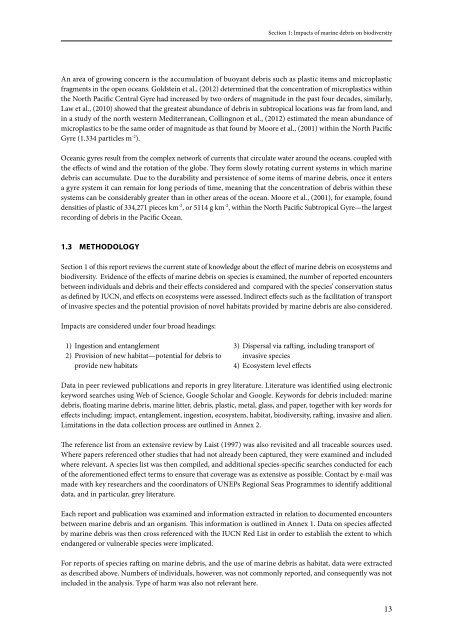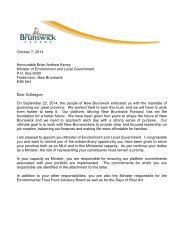cbd-ts-67-en
cbd-ts-67-en
cbd-ts-67-en
- No tags were found...
Create successful ePaper yourself
Turn your PDF publications into a flip-book with our unique Google optimized e-Paper software.
Section 1: Impac<strong>ts</strong> of marine debris on biodiversity<br />
An area of growing concern is the accumulation of buoyant debris such as plastic items and microplastic<br />
fragm<strong>en</strong><strong>ts</strong> in the op<strong>en</strong> oceans. Goldstein et al., (2012) determined that the conc<strong>en</strong>tration of microplastics within<br />
the North Pacific C<strong>en</strong>tral Gyre had increased by two orders of magnitude in the past four decades, similarly,<br />
Law et al., (2010) showed that the greatest abundance of debris in subtropical locations was far from land, and<br />
in a study of the north western Mediterranean, Collingnon et al., (2012) estimated the mean abundance of<br />
microplastics to be the same order of magnitude as that found by Moore et al., (2001) within the North Pacific<br />
Gyre (1.334 particles m -2 ).<br />
Oceanic gyres result from the complex network of curr<strong>en</strong><strong>ts</strong> that circulate water around the oceans, coupled with<br />
the effec<strong>ts</strong> of wind and the rotation of the globe. They form slowly rotating curr<strong>en</strong>t systems in which marine<br />
debris can accumulate. Due to the durability and persist<strong>en</strong>ce of some items of marine debris, once it <strong>en</strong>ters<br />
a gyre system it can remain for long periods of time, meaning that the conc<strong>en</strong>tration of debris within these<br />
systems can be considerably greater than in other areas of the ocean. Moore et al., (2001), for example, found<br />
d<strong>en</strong>sities of plastic of 334,271 pieces km -2 , or 5114 g km -2 , within the North Pacific Subtropical Gyre—the largest<br />
recording of debris in the Pacific Ocean.<br />
1.3 METHODOLOGY<br />
Section 1 of this report reviews the curr<strong>en</strong>t state of knowledge about the effect of marine debris on ecosystems and<br />
biodiversity. Evid<strong>en</strong>ce of the effec<strong>ts</strong> of marine debris on species is examined, the number of reported <strong>en</strong>counters<br />
betwe<strong>en</strong> individuals and debris and their effec<strong>ts</strong> considered and compared with the species’ conservation status<br />
as defined by IUCN, and effec<strong>ts</strong> on ecosystems were assessed. Indirect effec<strong>ts</strong> such as the facilitation of transport<br />
of invasive species and the pot<strong>en</strong>tial provision of novel habita<strong>ts</strong> provided by marine debris are also considered.<br />
Impac<strong>ts</strong> are considered under four broad headings:<br />
1) Ingestion and <strong>en</strong>tanglem<strong>en</strong>t<br />
2) Provision of new habitat—pot<strong>en</strong>tial for debris to<br />
provide new habita<strong>ts</strong><br />
3) Dispersal via rafting, including transport of<br />
invasive species<br />
4) Ecosystem level effec<strong>ts</strong><br />
Data in peer reviewed publications and repor<strong>ts</strong> in grey literature. Literature was id<strong>en</strong>tified using electronic<br />
keyword searches using Web of Sci<strong>en</strong>ce, Google Scholar and Google. Keywords for debris included: marine<br />
debris, floating marine debris, marine litter, debris, plastic, metal, glass, and paper, together with key words for<br />
effec<strong>ts</strong> including: impact, <strong>en</strong>tanglem<strong>en</strong>t, ingestion, ecosystem, habitat, biodiversity, rafting, invasive and ali<strong>en</strong>.<br />
Limitations in the data collection process are outlined in Annex 2.<br />
The refer<strong>en</strong>ce list from an ext<strong>en</strong>sive review by Laist (1997) was also revisited and all traceable sources used.<br />
Where papers refer<strong>en</strong>ced other studies that had not already be<strong>en</strong> captured, they were examined and included<br />
where relevant. A species list was th<strong>en</strong> compiled, and additional species-specific searches conducted for each<br />
of the aforem<strong>en</strong>tioned effect terms to <strong>en</strong>sure that coverage was as ext<strong>en</strong>sive as possible. Contact by e-mail was<br />
made with key researchers and the coordinators of UNEPs Regional Seas Programmes to id<strong>en</strong>tify additional<br />
data, and in particular, grey literature.<br />
Each report and publication was examined and information extracted in relation to docum<strong>en</strong>ted <strong>en</strong>counters<br />
betwe<strong>en</strong> marine debris and an organism. This information is outlined in Annex 1. Data on species affected<br />
by marine debris was th<strong>en</strong> cross refer<strong>en</strong>ced with the IUCN Red List in order to establish the ext<strong>en</strong>t to which<br />
<strong>en</strong>dangered or vulnerable species were implicated.<br />
For repor<strong>ts</strong> of species rafting on marine debris, and the use of marine debris as habitat, data were extracted<br />
as described above. Numbers of individuals, however, was not commonly reported, and consequ<strong>en</strong>tly was not<br />
included in the analysis. Type of harm was also not relevant here.<br />
13



